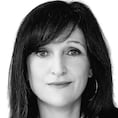Had I been bullied during my first year of secondary school, my first thought would have been of murder. I had no shortage of inspiration to draw from: glass vials of traceless poisons that could be surreptitiously cracked into a lunchtime flask; a revolver set to discharge only when a particular oven was opened during Home Economics; unfathomable post-PE disappearances on the way back to the changing room.
And if later on I was to calm down and feel less vengeful, why I’d simply wait for my large-brained butler to sidle in and fix everything while Bertie Wooster and I beetled off to the Drones Club for a straightener. But hey, don’t blame me for having problem-solving abilities that considered only blood-thirsty revenge or servants, blame Agatha Christie and PG Wodehouse.
It could have been worse: six years earlier Noddy would have advised me to shake a jingling hat at the whole business (he never was much of a role model, Noddy). And though the girls of Malory Towers and St Clare’s could have helped, I suspect many of Enid Blyton’s other characters wouldn’t have been of much use to me in my lonely predicament. The Famous Five, Secret Seven et al had far bigger fish to fry as, armed only with paper clips, ginger beer and invisible ink, they had to sort out all those crime rings, international smugglers and miscellaneous wrongdoers.
Our local mobile library divided at the top of the rickety stairs into children to one side and adults to the other. After school one day I simply turned right instead of left. (I know – as rites of passage go, this one was seriously on the dull side.) In this new-found adult kingdom I found shelves stuffed full of large print Agatha Christie and Jean Plaidy (I got through the lot), and rows and rows devoted to Mills & Boon (there’s time yet, I guess). Unfortunately for me these were pre-JK Rowling years, but I found the Poldark series quickly enough, and would go on to discover Daphne Du Maurier and David Lodge. I took on Jane Austen too young and lost: not only did I struggle with the language, but such delicately-filleted savagery and black humour went completely over my head. It was years before I got back into her good books.
There is a fictitious illustrated book – though inspired by many such real ones – called The Pantheon of Norwegian Folktales in my novel, The Heart of Everything. It’s a family heirloom given by a Norwegian father to his three Irish children. The stories in it have great titles (these are real) such as Ape Likes Her Own Children Best, and Fox Plays Dead And Is Thrown Out Of Pit. I decided Per Jensen would give his children a collection of folktales because one of the reasons these stories developed in oral cultures was to pass on societal norms and expectations. They illustrate codes of behaviour.
In The Heart of Everything, Elin, the youngest of the family and keen to please her father, loves the book. She enjoys how different these stories are from typical fairy tales; that they lack strong-armed princes and weeping princesses desperately seeking happy-ever-afters. Her older siblings dismiss it as being dull and irrelevant. But what neither uptight Anita or failed actor Raymond can see is that their father was implicitly trying to tell them something about how to navigate life, that books can become bridges between childhood and adulthood. In The Heart of Everything, Raymond, Anita and Elin’s mother Mags goes missing, and although grown-up and estranged from each other, the three of them are forced together almost as children again in order to search for her.
Writing the siblings’ reactions to The Pantheon of Norwegian Folktales made me wonder about the books that help us move from childhood to adulthood. There have been times when the gaps in my knowledge seemed so vast it was as if Miss Marple had collected me from Malory Towers at the end of term and brought me straight to St Mary Mead for a cream tea’n’crime. Reading introduces us to the world, and because I went from Enid Blyton in a fairly straightish line (with minor deviations such as KP Peyton’s Flambards series, and Joan Lingard’s fantastic Belfast-set Kevin and Sadie books) to Agatha Christie and PG Wodehouse, I suspect I missed out on a number of significant life pointers, the sort of things so successfully delivered now by Young Adult fiction.
This year’s schools and families programme in the Mountains To Sea Book Festival in Dún Laoghaire (March 9th-13th) has a big selection of children’s and YA talks and events. And yes, I know that I can go as an adult and enjoy them too, but I am envious of the children and teenagers who will watch their favourite books come to life around them and hear them discussed and debated and argued over as real, important things in their own right, not just silent, private words. And though I will never begrudge a minute I have spent in the company of PG Wodehouse, I do envy the book bridges that now exist and will help guide my own children towards adulthood. The stories and situations that will bring them darkness and joy. The characters who will someday help them understand and articulate their own feelings about bullying and friendship; about identity and sexuality, school and family and fun.
About the things that really matter when you’re ready to turn right instead of left at the top of the library steps.
Henrietta McKervey is the author of What Becomes of Us and The Heart of Everything, which is published today by Hachette Books Ireland


















